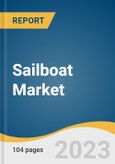The global sailboat market size is predicted to reach USD 4.62 billion by 2030, registering a CAGR of 4.2% from 2023 to 2030. The market is a dynamic industry shaped by a combination of factors that cater to sailing enthusiasts worldwide. It encompasses a wide range of sailboat types, from small dinghies to luxurious yachts, each offering unique experiences for a diverse customer base. Several key factors influence the dynamics of this market, reflecting its adaptability to changing consumer preferences, environmental concerns, and technological advancements. One of the significant drivers of the market growth is the rising interest in recreational boating. People seek outdoor activities and leisure experiences, which drives market growth.
The appeal of setting sail, exploring coastlines, and experiencing the tranquility of open waters resonates with both seasoned sailors and newcomers to the sport. The traditional monohull sailboats, cherished for their classic design and aesthetics, continue to be popular choices, especially among those who value the authenticity and heritage of sailing. Moreover, economic conditions play a substantial role in shaping the sailboat market. Factors like disposable income levels, consumer confidence, and overall economic health directly impact purchasing decisions. During periods of economic prosperity, individuals are more likely to invest in leisure activities like sailing, contributing to market growth. However, economic downturns can lead to reduced sales and fluctuations in demand.
In recent years, there has been a growing focus on sustainability and eco-consciousness, which has influenced sailboat designs. Sailboat manufacturers are increasingly incorporating eco-friendly features like electric propulsion systems, solar panels, and efficient waste management solutions. This aligns with the broader societal shift towards environmental responsibility and appeals to a market segment seeking greener alternatives. Technological advancements have also transformed the sailboat market. Innovations in sail controls, navigation systems, and materials have improved safety and performance. In addition, digitalization has played a significant role, with virtual boat tours, online sales platforms, and digital navigation aids becoming standard practices in the industry.
The appeal of setting sail, exploring coastlines, and experiencing the tranquility of open waters resonates with both seasoned sailors and newcomers to the sport. The traditional monohull sailboats, cherished for their classic design and aesthetics, continue to be popular choices, especially among those who value the authenticity and heritage of sailing. Moreover, economic conditions play a substantial role in shaping the sailboat market. Factors like disposable income levels, consumer confidence, and overall economic health directly impact purchasing decisions. During periods of economic prosperity, individuals are more likely to invest in leisure activities like sailing, contributing to market growth. However, economic downturns can lead to reduced sales and fluctuations in demand.
In recent years, there has been a growing focus on sustainability and eco-consciousness, which has influenced sailboat designs. Sailboat manufacturers are increasingly incorporating eco-friendly features like electric propulsion systems, solar panels, and efficient waste management solutions. This aligns with the broader societal shift towards environmental responsibility and appeals to a market segment seeking greener alternatives. Technological advancements have also transformed the sailboat market. Innovations in sail controls, navigation systems, and materials have improved safety and performance. In addition, digitalization has played a significant role, with virtual boat tours, online sales platforms, and digital navigation aids becoming standard practices in the industry.
Sailboat Market Report Highlights
- The monohull segment market is expected to witness substantial growth with a CAGR of 3.7% since monohull sailboats are well-suited for long-distance cruising and are gaining popularity among sailors seeking adventure and exploration
- By length, the 20-50 ft. segment accounted for the maximum share of 58.9% in 2022. Innovations in materials ranging from carbon fiber to advanced composites have a profound impact on the weight, strength, and overall performance of sailboats within the 20-50 ft. size range
- Although the COVID-19 pandemic restricted market growth due to travel restrictions, it led to high-net-worth individuals desiring private and exclusive holidays. It has also changed the way sailboat companies are carrying out their business. Companies are embracing digital transformation and investing in new websites to sell and charter sailboats virtually
- The Asia Pacific regional market growth is fueled by factors, such as economic prosperity and a growing middle-class population, which propel the demand for sailing as a leisure pursuit, particularly in countries, such as China and India
- The global market is oligopolistic and is dominated by key players, such as Hallberg-Rassy Varvs AB, Groupe Beneteau, and Catalina Yachts
Table of Contents
Chapter 1. Methodology and Scope
Chapter 2. Executive Summary
Chapter 3. Market Variables, Trends, & Scope Outlook
Chapter 4. Sailboat Market Hull Type Outlook
Chapter 5. Sailboat Market Length Outlook
Chapter 6. Sailboat Market: Regional Estimates & Trend Analysis
Chapter 7. Sailboat Market Competitive Landscape
List of Tables
List of Figures
Companies Mentioned
- Hallberg-Rassy Varvs AB
- Groupe Beneteau
- Catalina Yachts
- HanseYachts AG
- CANTIERE DEL PARDO S.p.A.
- Fountaine Pajot
- OYSTER YACHTS
- Nautor Swan Srl
- BAVARIA YACHTS
- Najad
Methodology

LOADING...
Table Information
| Report Attribute | Details |
|---|---|
| No. of Pages | 104 |
| Published | October 2023 |
| Forecast Period | 2022 - 2030 |
| Estimated Market Value ( USD | $ 3353.3 Million |
| Forecasted Market Value ( USD | $ 4620 Million |
| Compound Annual Growth Rate | 4.2% |
| Regions Covered | Global |
| No. of Companies Mentioned | 10 |








